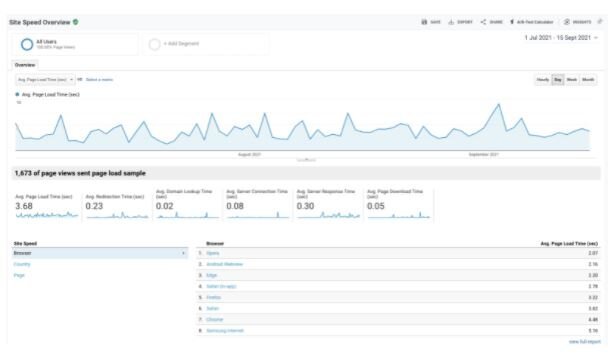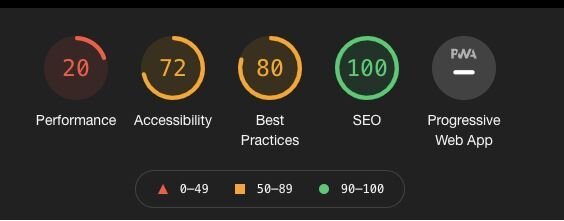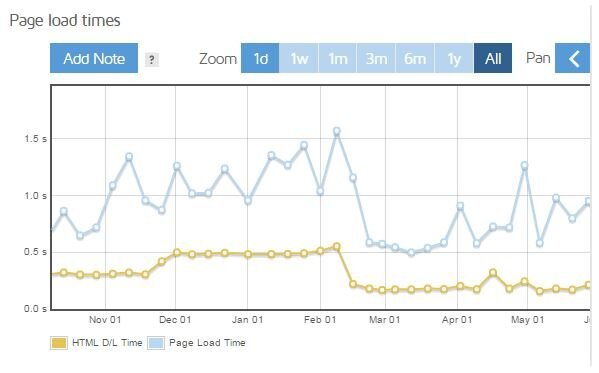Can Page Load Time Affect Your Conversion Rate?
Can a low site speed affect my conversion?
How site speed impacts conversions
Ever spotted a site in your Google results that has the exact information you need but takes forever to load?
Frustrating, right?
Marketers call this friction
Reducing friction is one of the main goals of Conversion Rate Optimization.
Slow site speed bombs your conversion rate
When page load times are too long, users get annoyed and will leave your page. According to a Hubspot research report, a one second delay leads to a 7% percent reduction in conversions.
For a site with a monthly turnover of $1,000,000, that adds up to over $800,000 in lost revenue every year.
Slow site speed damages your SEO and Google Ads Quality Score
Google considers hundreds of ranking factors when determining your page rank – this includes SITE SPEED.
Low-performing website means poor user experience, and search engines will penalize you for that.
Slow load times also impact your pages’ search engine rankings and Google Ads Quality Score. As a site owner, this means less paid and organic traffic and lower ROI on your SEO spend.
Where and how to start with optimization?
How to do site speed optimization
We’ve established why site speed isimportant. Let’s take a look how we can fix this..
The best place to start is with the changes that will improve your speed, especially on pages that are critical to conversions.
Google Analytics’ Site Speed reports (GA -> Behavior -> Site Speed) show how quickly users can see and interact with content. Use those insights to guide your optimization efforts and track any improvement you make.
Pay particular attention to conversion-critical pages – if your landing pages, home page, shopping carts, payments, etc., are loading very slowly, it’s very likely they’re costing you conversions.
What is the minimum site speed?
Your website page speed needs to be as fast as you can make it - without compromising the customer experience.
You should optimize your website speed to an acceptable level (see below for some helpful tools!) – ideally less than 1-2 seconds for mobile sites. But remember – traffic is a zero-sum game, so ideally you should aim to get at least a slightly higher score than your competitors.
How to test website speed?
Tools like GTMetrix, Google Pagespeed Insights, Pingdom, and Lighthouse - run tests on your desktop and mobile sites site and provide recommendations on how to boost performance.
Lighthouse
GTMetrix
How can I check how my competitors are performing?
You can assess competitors’ site speed using the same tools as for your website.
Can speed optimization impact other areas of my website?
Yes - Solution to one problem can have a negative impact on another aspect of your site. We recommend analyzing the website speed after each change.
AMP from Google - what it is, and when shall we use it?
Accelerated Mobile Pages (AMP) is an open-source framework allowing you to create simple mobile websites that load almost instantly.
AMP has generated controversy in the publishing world, but its benefits for site speed are clear.
The main components of AMP are reduced JavaScript and CSS elements and the use of a Content Delivery Network. Many CMS platforms allow downloading AMP plugins which help to translate your pages into AMP.
I am running e-commerce on one of the platforms (e.g. Shopify, BigCommerce, etc) - is it still possible to improve site speed, is it worth the effort, or shall I assume that the platform has already been optimized?
E-commerce platforms are partially optimized by default, but it’s only a generic optimization, and you should perform site-speed optimization suited for your business case.
All the steps we’ll cover below can be applied to major e-commerce platforms, and many have plugins that will make the process easier.
I’d like to keep an eye on the site speed. What are the tools for ongoing monitoring?
What is a reasonable granularity - daily, hourly?
How can I benefit from granular(hourly) monitoring?
GTMetrix and Pingdom allow you to monitor your site speed with a specified time interval. Granularity depends on how often you perform changes on your website, which can affect site-speed or its accessibility.
Usually, daily granularity will be enough. Very granular monitoring will allow you to quickly take action if speed issues occur on your website.
I would like to see the impact of site speed on how users behave on-site. What are the relevant metrics and dimensions from Google Analytics?
To analyse user behaviour in GA related to site speed, you should use the device category and browser dimensions in conjunction with bounce rate and time on page metrics.
It will allow you to determine what devices and browsers are the most problematic and if your changes had an impact on one of the above metrics for specific devices.
I would like to see if there is a correlation between site speed and conversion- pull such data from Google Analytics?
After implementing site-speed optimization changes, you can check in GA if the conversion rate metric was affected.
It’s good practice to add appropriate annotations to GA after implementing site side changes. In future, it might help you to understand related changes in traffic and conversions.
Site speed areas to check:
CDN
A content delivery network is a set of web servers distributed across various geographical locations that provide web content to end-users depending on their location. Popular CDNs include Cloudflare and Amazon Cloudfront.
When you host your website on a single server, all user requests are sent to the same hardware, increasing the time to process each request when your server sees an uptick in traffic. Load times also increase when users are physically far from the server – if your server is located in London and a user connects from Australia, that’s going to impact your site speed.
CDNs redirect requests to the nearest server in the network, resulting in faster content delivery and quicker websites.
Image optimization
Images should be:
No larger than they need to be
In the right format
PNGs are generally better for graphics with fewer than 16 colors
JPEGs are generally better for photographs
Compressed for the web using tools like ImageOptim, JPEGmini, or Kraken
Another way to reduce image size is to use HTML <secret> and <size> attributes that adjust image size based on user display properties.
Reduce the number of plugins
Server memory and runtime are finite, and plugins are a major culprit for hogging your servers’ resources. The more plugins you have installed, the more resources are needed to run them.
Without careful attention, your site is likely to accumulate more plugins as time passes, some of which you may not even use.
The result? A slower website and a host of potential security issues.
That’s why auditing your plugins and deleting the unnecessary ones is one of the most important step in optimizing your site speed.
Start by running performance tests to find out which plugins are slowing down your website. Try to avoid plugins that load a lot of scripts and styles or generate a lot of database queries.
The best solution is to keep only the necessary ones and ensure that they are kept up to date.
Warning: Removing important plugins or resources can break important site features including shopping carts and checkouts.
If you didn’t build your site and don’t know precisely what everything does, leave this task to your developer.
Minimize the number of JS and CSS files
If your website contains a lot of JavaScript and CSS files, it leads to lots of HTTP requests. These requests are treated individually by your visitor’s browser and slow your sites’ performance.
By optimizing your code (including removing spaces, commas, and other unnecessary characters), you can dramatically increase your page speed. Also remove code comments, formatting, and unused code.
Google recommends using CSSNano and UglifyJS.
Use caching
Caching is the process of storing the current version of your website on the hosting and serving this version to users until your website is updated.
Think of it like a snapshot of your site in time. Instead of sending new database requests and rendering your site over and over for every new visitor, your server can just send users the snapshot.
Use a tool like YSlow to see if you already have an expiration date set for your cache. Then set your "expires" header for how long you want that information to be cached.
In many cases, unless your site design changes frequently, an entire year is a reasonable time period. But of course, your mileage may vary, and certain sites may need to update the cache a lot more frequently.
Google has more information about leveraging caching here: https://code.google.com/speed/page-speed/docs/caching.html
Enable Gzip compression
Gzip is a format which compresses files on your server before sending them to the users browser, where they are unzipped and displayed.
Gzip speeds up your site by minimizing HTTP requests and reducing server response time.
Aim to use Gzip for CSS, HTML, and JavaScript files larger than 150 bytes. DON’T use Gzip on image files, which should be compressed using a program like Photoshop where you can retain control over the quality of the image.
Reduce redirects
Each time a page redirects to another page, your visitor faces waiting time while the HTTP request-response cycle completes.
We advise to keep redirects to a minimum or eliminate them entirely.
Start by identifying all redirects on your page by running a site scan. Next, use a tool like Screaming Frog to quickly identify redirects.
If a redirect serves some important purpose - like a 301 redirect for SEO purposes - keep it. Otherwise, try your best to get rid – and think carefully in future about how you can avoid using unnecessary redirects on your page.
Use prefetching
Prefetching is a technique in which your server instructs the user's browser to download resources before the user gets to them. It works well if you can anticipate user actions and, for instance, load some content or links in advance.
There are three main types of prefetching:
1. DNS-prefetching
This practice entails resolving domains into IP addresses in advance.
2. Link Prefetching
If you are sure that a user will click on a specific link, you can apply this type of prefetching.
This method is useful for stable user journey actions, such as moving to the shopping cart page after one or several items are added.
3. Prerendering
This approach means rendering an entire page or some elements of it in advance.
While prefetching is effective, it requires deep user behaviour analysis to make precise assumptions.









